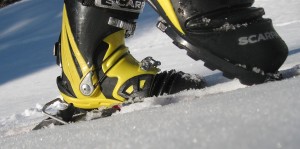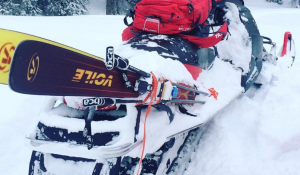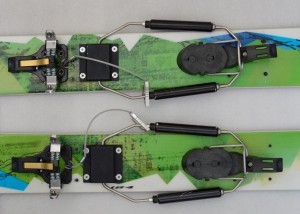Telemark Tech bindings are here to stay.
The 2-pin connnection
When Mark Lengel first proposed the idea of the Telemark Tech System (TTS) skepticism was the typical response. That’s a near universal first impression of the confidence inspired by the lowly 2-pin tech toe, also known by its founding brand name, Dynafit, or other terms like low-tech, pin-tech, or merely as “tech” when spoken of over beers at the trailhead. Mr. Lengel knew better; those tiny pins can bite tight on the tip of a boot, which meant they might work for tele. As time always seems to prove with the puny 2-pin toe, it is unquestionably tough enough, especially I dare say, for tele.
NTN Boots required
In a nutshell the telemark tech system takes a generic telemark cable binding and replaces the 75mm toe plate with a tech-toe. Of course, this necessitates a boot with bellows and tech inserts at the toe. The choices at retail boil down a handfull of NTN boots: Crispi Evo, Shiver, or World Cup, Scarpa TX-Pro, or Scott’s Voodoo NTN. Scarpa’s early F1 and F3, the ones with the bellows, work too, but that’s only in the used market.
In theory you could get extreme in the do-it-yourself tangent and install inserts in a pair of tele boots, NTN or 75mm, but what value would a PhD in tele minutia get you? I mean, talk about the potential for trouble. Besides, Salomon already proved you can’t just “solder” those things on.
Dynafit touring efficiency
There are two advantages inherent with the tech toe. Not only is it lighter weight overall, it is unquestionably the most efficient too. When you skin with 2-pins, you only lift your boot. With all other free pivot bindings you’re also lifting part of the binding — some more than others.Better Edging
Lest you think otherwise, the low-tech toe delivers superb edging thanks to the lateral stiffness of the pins. Again, you wouldn’t think those two pins could hold so tight, but results prove they do.
Adjustable Power
Though not a benefit of the 2-pin toe per se, depending on where you position the cable, a telemark tech binding can yield nearly any level of activity on the Hammerhead scale, potentially even higher.
Change the connection from the real heel to the NTN second heel and the results are, arguably, even better. Those who have adopted Meidjo, the first 2-pin NTN binding, consistently report the engagement is faster, thanks to the lateral stiffness of the tech pins, and smoother because the tele tension is connected mid-sole reducing pressure at the ski tips.Just Believe
If you’re among those who can’t believe it until you see it, remember there are hundreds of thousands of Dynafit converts now, so just give it a try and you’ll see, it really does work.
In case you wondered who else believes in tech for tele consider three from across the Atlantic: the M-Equipment in France, mythical Moonlight from Norway, and Italy’s Kreuzspitze, not to mention 22 Design’s recently announced Lynx. Add to that an untold number of garage-band do-it-yourselfers. Since imitation IS the sincerest form of flattery there are a lot of people who admire TTS for its lightweight, simplicity, and control.Fit as a Fiddle
It isn’t mainstream yet because it requires a willingness to fiddle with the binding (it is an unavoidable part of the Dynafiddle legacy), either mounting ’em (Meidjo requires 13 holes), and usually just getting in to the binding. However, when you get the hang of it you can get in with just a flick of a fiddle. YMMV depending on snow conditions.
The overriding appeal of the TTS system is simplicity and light weight. If you like earning your tele turns a TTS rig of some sort is in your future.Keep It Simple
To keep it simple get the full TTS binding from Olympus Mountain Gear. Alternatively, if you already have a set of tech toes in your quiver, or prefer another brand, get the TTS cable kit and join the ranks of the TTS do-it-yourselfers. It is recommended as a first foray into the TTS world if you have the tools and mounting know-how.
Make it Simple
Here’s the other thing. The limit of this system is the springs which limit out. I’ll provide the details on that in a few more episodes. Because the system is so simple you may be tempted to build your own cable assembly. For those with the right tools and some design experience, especially with the advent of 3D printers, it is possible to come up with a pretty slick system that can provide equal or better performance than what is off the shelf.
In future articles on this subject, I will show you how to optimize the cable position, install inserts, plus some examples of home-brewed cable assemblies for OMG, Dynafit and G3 tech toes.
Special thanks to rjmh, jnichol, chamonix, kenji, dschane, and jasonq for sharing their results of tinkering with TTS.
© 2017
The original version of this article first appeared on TelemarkSkier.com. Minor edits have been made in this version, but the message remains the same. TTS rules and you can DIY.






2 comments
1 ping
So what’s the latest on when we’ll see a new crop of boots from Scarpa?
Hopefully we’ll see what they have up their sleeve next January – 2019. So Fall 2019. Cross your fingers.
[…] Posts DIY 2-pin Tele Chronicles: State of the Art DIY 2-pin Tele Chronicles: Picking your […]